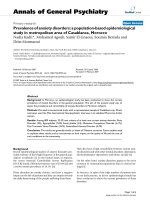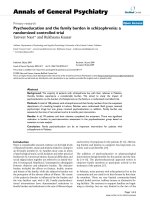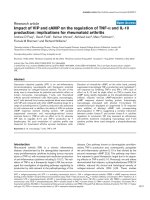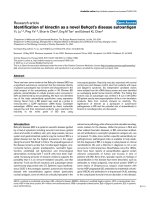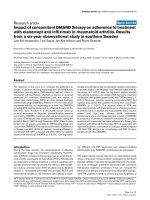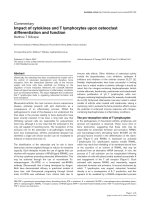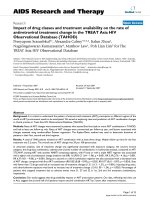Báo cáo y học: "Impact of the factor V Leiden mutation on the outcome of pneumococcal pneumonia: a controlled laboratory study" ppsx
Bạn đang xem bản rút gọn của tài liệu. Xem và tải ngay bản đầy đủ của tài liệu tại đây (1.48 MB, 11 trang )
RESEARCH Open Access
Impact of the factor V Leiden mutation on the
outcome of pneumococcal pneumonia: a
controlled laboratory study
Marcel Schouten
1,2*
, Cornelis van’t Veer
1,2
, Joris JTH Roelofs
3
, Marcel Levi
4
, Tom van der Poll
1,2,4
Abstract
Introduction: Streptococcus (S.) pneumoniae is the most common cause of community-acquired pneumonia. The
factor V Leiden (FVL) mutation results in resistance of activated FV to inactivation by activated protein C and
thereby in a prothrombotic phenotype. Human heterozygous FVL carriers have been reported to be relatively
protected against sepsis-related mortality. We here determined the effect of the FVL mutation on coagulation,
inflammation, bacterial outgrowth and outcome in murine pneumococcal pneumonia.
Methods: Wild-type mice and mice heterozygous or homozygous for the FVL mutation were infected intranasally
with 2*10
6
colony forming units of viable S. pneumoniae. Mice were euthanized after 24 or 48 hours or observed in
a survival study. In separate experiments mice were treated with ceftriaxone intraperitoneally 24 hours after
infection and euthanized after 48 hours or observed in a survival study.
Results: The FVL mutation had no consistent effect on activation of coagulation in either the presence or absence
of ceftriaxone therapy, as reflected by comparable lung and plasma levels of thrombin-antithrombin complexes
and fibrin degradation products. Moreover, the FVL mutation had no effect on lung histopathology, neutrophil
influx, cytokine and chemokine levels or bacterial outgrowth. Remarkably, homozygous FVL mice were strongly
protected against death due to pneumococcal pneumonia when treated with ceftriaxone, which was associated
with more pronounced FXIII depletion; this protective effect was not observed in the absence of antibiotic therapy.
Conclusions: Homozygosity for the FVL mutation protects against lethality due to pneumococcal pneumonia in
mice treated with antibiotics.
Introduction
Streptococcus pneumoniae is the leading causative
pathogen in community-acquired pneumonia ( CAP) [1].
An estimated 570,000 cases of pneumococcal pneumo-
nia occur in the USA annually, resulting in 175,000 hos-
pitalizations. CAP is a frequent cause of sepsis: in a
recent sepsis trial 35.6% of the patients suffered f rom
severe CAP, with S. pneumoniae as the most frequent
cause [2,3]. Worldwide S. pneumoniae is responsible for
an estimated 10 million deaths annually, making pneu-
mococcal pneumonia and sepsis a major health threat
[4]. This together with an increasing incidence of
antibiotic resistance in this pathogen [1], ur ges us to
expand our knowledge of the host defense mechanisms
that influence the outcome of pneumococcal pneumonia
and sepsis.
Severe infection and inflammation have been closely
linked to the activation of coagulation and downregula-
tion of anticoagulant mechanisms and fibrinolysis
(reviewed in [5]). These hemostatic changes, favoring a
procoagulant state, have also been shown in the pul-
monary compartment of patients and experimental ani-
mals with pneumococcal pneumonia and sepsis [6-10].
The factor V Leiden (FVL) mutation, a missense muta-
tion in the FV gene that replaces arginine at position
506 with glutamine, resulting in resistance of activated
FV (FVa) to inactivation by activated protein C (APC)
[11], is a major risk factor for venous thrombo-embo-
lism [12]. The high prevalence of this mutation - 4 to
* Correspondence:
1
Center for Experimental and Molecular Medicine (CEMM), Academic Medical
Center, University of Amste rdam, room G2-130, Meibergdreef 9, 1105 AZ,
Amsterdam, the Netherlands
Full list of author information is available at the end of the article
Schouten et al. Critical Care 2010, 14:R145
/>© 20 10 Schouten et al.; licensee BioMed Central Ltd. This is an open access article distribute d under the terms of the Cr eativ e
Commons Attribution License ( which permits unrestricted use, distribution, and
reproduction in any medium, provided the original work is properly cited.
6% in Causasians - despite its prothrombotic effects, has
prompted speculation that the mutation might be sub-
ject to positive selection pressure during evolution [13].
It has been speculated that FVL carriers might benefit
from reduced blood loss du ring infancy and tha t the
heterozygous FVL carrier status m ight improve embryo
implantation via an unknown mechanism [14,15]. An
alternative hypothesis f or a survival advantage for het-
erozygous FVL carriers has been suggested by the obser-
vation in patients with severe sepsis that heterozygous
FVL carriers had a lower mortality than non-carriers
and by an imal studies showing an increased survival for
heterozygous FVL mice in murine endotoxemia as com-
pared with wild-type (WT) mice [16,17]. However, FVL
Leiden mice displayed an unaltered mortality in experi-
mental sepsis induced by viable Escherichia coli or
group A streptococci [18,19].
The impact of the FVL mutation on the outcome of
severe pneumococcal pneumonia has not been studied
to date. Therefore, we here investigated whether carrier-
ship of the FVL mu tation influences the host response
to respiratory tract infection by S. pneumoniae. For this
we infected heterozygous and homozygous FVL mice
with viable S. pneumoniae and compared their responses
with regard to activation of coagulation, inflammation,
bacterial outgrowth and dissemination and mortality
with those in normal WT mice, both in an untreated
and in an antibiotic-treated setting, the latter model
more closely mimicking the clinical situation.
Materials and methods
Animals
FVL mice carrying an R504Q amino acid mutation [20]
were backcrossed four times to a C57BL/6J background
(N4) whereafter N4 heterozygous FVL mice were inter-
crossed to obtain WT, heterozygous and homozygous
offspring (confirmed by genotyping) for experiments.
Mice wer e bred and maintained in the animal care facil-
ity of the Academic Medical Center, University of
Amsterdam, the Netherlands, according to institutional
guidelines with free access to food and water. Sex- and
age-matched (9 to 11 week old) mice were used in
experiments. All experiments were approved by the
Institutional Animal Care and Use Committee of the
Academic Medical Center.
Experimental infection and treatment
Pneumonia was induced by intranasal inoculation with
about 2 × 10
6
colony forming units (CFU) of S. pneumo-
niae serotype 3 (American Type Culture Collection,
ATCC 6303, Rockville, MD, USA) as described pre-
viously [7,10,21]. Mice we re sacrificed after 24 or 48
hours or observed in a survival study. In separate
experiments mice were treated once intraperitoneally
with ceftraxione (500 μg; Pharmachemie BV, Haarlem,
the Netherlands) at 24 hours after infection and were
either sa crificed at 48 hours after infec tion or observed
in a survival study. Sample harvesting and processing,
and determination of bacterial loads and cell counts
were performed as described [7,10,21].
Assays
Thrombin-antithrombin complexes (TATc; Behring-
werke AG, Marburg, Germany), fibrin degradation pro-
ducts (FDP) [22], plasminogen activator inhibitor-1
(PAI-1) [23], keratinocyte-derived chemokine (KC),
macrophage inflammatory protein (MIP)-2 (both R&D
systems, Minneapolis, MN, USA) and myeloperoxidase
(MPO; HyCult Biotechnology, Uden, the Netherlands)
were measured by ELISA. Pl asminoge n activator activity
(PAA) was determined by an amidolytic assay [24].
TNF-a, IL-6, monocyte chemoattractant protein (MCP)-
1, IL-12p70, interferon (IFN)-g and IL-10 were measured
by cytometric bead array multiplex assay (BD Bios-
ciences, San Jose, CA, USA).
Factor XIII blots
Immunopurified sheep-anti-human FXIIIA immunoglo-
bulin(Ig)GwasobtainedfromKordia(Leiden,The
Netherlands). For western blotting plasma proteins were
separated by polyacrylamide SDS gel electrophoreses
under non-reducing conditions and transferred to
Immobilon P (Pharmacia, Piscataway, NJ, USA) polyvi-
nylidene difluoride membranes. Membranes were
blocked in block buffer containing 5% nonfat dry milk
proteins and 0.1% Tween-20 in 50 mM Tris, 150 mM
NaCl, pH 7.4 (TBS-T), washed with 0.1% Tween in TBS
and incubated overnight with primary antibody in block
buffer at 4°C. After washing with 0.1% Tween-20 in TBS
membranes were probed with peroxidase labeled sec-
ondary antibody for one hour at room temperature in
1% BSA in TBS-T. After washing with TBS-T mem-
branes were incubated with Lumi-LightPlus Western
Blotting Substrate (Roche, Mijdrecht, the Netherlands)
and positive bands were detected using a Fujifilm LAS-
3000 Imager (Fujifilm, Tokyo, Japan). Intensity of the
bands was quantified using the AIDA Biopackage 1 D
Quantification software (Raytest, Pittsburgh, PA, USA)
and was corrected for total protein amount.
Histology and immunohistochemistry
Paraffin lung sections were stained with H&E or fluores-
cein isothiocyanate-labeled anti-mouse Ly-6G mAb
(Pharmingen, San Diego, CA, USA) as described [25,26].
Fibri n(ogen) staining was performed as described [7,27].
To score lung inflammation, the lung surface was ana-
lyzed with respect to the following parameters by a
pathologist who was blinded for groups: bronchitis,
Schouten et al. Critical Care 2010, 14:R145
/>Page 2 of 11
interstitial inflammation, edema, endothelial itis, pleuritis
and thrombus formation. Each parameter was graded on
a scale of 0 to 4 (0: absent, 1: mild, 2: moderate, 3:
severe, 4: very severe). T he total histopathological score
was expressed as the sum of the scores for the different
parameters. Ly-6G and fibrin(ogen) stained slides were
photographed with a microscope equipped with a digital
camera (Leica CTR500, Leica Microsystems, Wetzlar,
Germany). Stained areas w ere analysed with Image Pro
Plus (Media Cybernetics, Bethesda, MD, USA) and
expressed as percentage of the total s urface area. The
average of 10 pictures was used for analysis.
Statistical analysis
Data are expressed as box-and-whisker diagrams depicting
the smallest observation, lower quartile, median, upper
quartile and largest observation or as survival curves. Dif-
ferences betwe en g roups we re determined with Krus kal-
Wallis - followed by D unn’s multiple comparison test in
case of statistical significance, Mann-Whitney U test or
log rank test where appropriate. Analyses were performed
using GraphPad Prism version 4.0 (GraphPad Software,
San Diego, CA, USA). P-values of less than 0.05 were con-
sidered statistically significant.
Results
Untreated setting
Activation of coagulation
To determine whether the FVL mutation impacts on
local or systemic activation of coagulation in pneumo-
coccal pneumonia we determined levels of TATc and
FDP in lung homogenates (Figures 1a and 1b) and
plasma (Figures 1c and 1d) in WT, heterozygous and
homozygous FVL mice 24 and 48 hours after intranasal
inoculation with viable S. pneumoniae. Pulmonary TATc
levels were upregulated as compared with baseline (not
shown) but were not different between the groups at 24
hours after infection. Remarka bly, heterozygous FVL
mice had slightly, but statistically significantly, lower
pulmonary TATc levels as compared with W T mice
after 48 hours, whereas homozygous FVL mice had
unaltered TATc levels. There were no differences
between the groups in TATc levels in plasma and in
FDP levels in lungs or plasma at both time po ints. To
further substantiate activation of c oagulation during
pneumococcal pneumonia, we performed fibrin(ogen)
staining on lungs harv ested 24 hours (not shown) or 48
hours after infection ( Figures 1e, f and 1g). No differ-
ences were seen between WT, heterozygous and homo-
zygous FVL mice (Figure 1h). To determine the impact
of the FVL mutation on fibrinolysis we determined PAI-
1 levels and PAA in lungs and plasma. There were no
differences in PAI-1 and PAA in lungs and plasma at
either 24 or 48 hours after infection (data not shown).
Pulmonary and systemic inflammation
Pneumococcal pneumonia was associated with pulmo n-
ary inflammation as evidenced by the occurrence of
bronchitis, interstitial inflammation, edema and
endothelialitis both at 24 hours (not shown) and 48
hours a fter infection in all mouse strains (Figures 2a, b
and 2c). There were no differences in total histopatholo-
gical scores between WT, heterozygous and homozy-
gous FVL mice at 24 hours or 48 hours after infection
(Figure 2d). Moreover, there were no differences in the
separate scores for bronchitis, interstitial inflammation,
edema or endothelialitis (not shown). One of the promi-
nent features in pneumococcal pneumonia is neutrophil
influx into the lung parenchyma both after 24 hours
(not shown) and 48 hours (Figures 2e, f and 2g). There
were no differences in neutrophil influx between WT,
heterozygous and homozygous FVL mice as evidenced
by equal percentages of positivity in Ly-6G stainings
both at 24 hours and 48 hours after infection (Figure
2h). In line w ith their similar histopathology a nd Ly-6G
scores, pulmonary MPO concentrations, indicative for
the number of neutrophils in lung tissue, were similar in
WT, heterozygous and homozygous FVL mice at both
24 and 48 hours after infection (Table 1).
To obtain further insight into the impact of the FVL
mutation on pulmonary inflammation during pneumoc-
cal pneumonia, we measured the levels of various cyto-
kines and chemokines in lung homogenates prepared 24
and 48 hours after infection (Table 1). At both time
points there were no differences in levels of TNF-a,IL-
6, IL-12, IFN-g,IL-10,MCP-1,KCorMIP-2.Toobtain
further insight into the impact of the FVL mu tatio n on
systemic inflammation, we mea sured plasma leve ls of
the above mentioned cytokines. Plasma cytokine levels
were either n ot different between the groups (TNF-a,
IL-6, IFN-g) or below detection (MCP-1, IL-12, IL-10)
at both 24 and 48 hours after infection (data not
shown).
Bacterial outgrowth
To investigate the effect of the FVL mutation on bacter-
ial outgrowth and dissemination i n pneumococcal pneu-
monia, we determined bacterial loads in lung, blood and
spleen 24 and 48 hours after i nfection. There were no
differences in bacterial loads in lung, blood or spleen
between the groups at both time points (Figures 3a, b
and 3c).
Survival
To determine whether the FVL mutation impacts on
mortality i n pneumococcal pneumonia we performed a
survival study. Despite the absence of clear differences
in coagulation, fibrinolysis, pulmonary and systemic
inflammation and bacterial loads, homozygous FVL
mice tended to die earlier than WT and heterozygous
mice (Figure 4), but this difference did not reach
Schouten et al. Critical Care 2010, 14:R145
/>Page 3 of 11
Figure 1 Acti vation of coagulation and pulmonary fibrin deposition in untreated pneumococ cal pneumonia. Levels of (a, c) thrombi n-
antithrombin complexes (TATc) and (b, d) fibrin degradation products (FDP) in (a, b) lung and (c, d) plasma 24 and 48 hours after induction of
pneumococcal pneumonia in wild-type mice (white, n = 8) and mice heterozygous (light grey white, n = 8) or homozygous (dark grey white,
n = 8) for the factor V Leiden mutation. Representative slides of lung fibrin staining (brown) 48 hours after induction of pneumococcal
pneumonia in (e) wild-type mice, (f) mice heterozygous and (g) mice homozygous for the factor V Leiden mutation (original magnification ×
100). (h) Quantitation of pulmonary fibrin content 24 and 48 hours after induction of pneumococcal pneumonia in wild-type mice (white white,
n = 8) and mice heterozygous (light grey white, n = 8) or homozygous (dark grey white, n = 8) for the factor V Leiden mutation. Data are
expressed as box-and-whisker diagrams depicting the smallest observation, lower quartile, median, upper quartile and largest observation.
** indicates statistical significance as compared to wild-type mice (P < 0.01 Kruskal-Wallis test followed by Dunn’s multiple comparison test).
Schouten et al. Critical Care 2010, 14:R145
/>Page 4 of 11
Figure 2 Lung histopathology and neutrophil influx in untreated pneumococcal pneumonia. Lung haematoxylin and eosin staining
48 hours after pneumococcal pneumonia in (a) wild-type mice, (b) mice heterozygous and (c) mice homozygous for the factor V Leiden
mutation (original magnification × 100). (d) Total lung pathology score 24 and 48 hours after induction of pneumococcal pneumonia in wild-
type mice (white white, n = 8) and mice heterozygous (light grey white, n = 8) or homozygous (dark grey white, n = 8) for the factor V Leiden
mutation. Representative slides of lung Ly-6G staining (brown) 48 hours after induction of pneumococcal pneumonia in (e) wild-type mice, (f)
mice heterozygous and (g) mice homozygous for the factor V Leiden mutation (original magnification × 100). (h) Quantitation of pulmonary Ly-
6G content 24 and 48 hours after induction of pneumococcal pneumonia in wild-type mice (white white, n = 8), and mice heterozygous (light
grey white, n = 8) or homozygous (dark grey white, n = 8) for the factor V Leiden mutation. Data are expressed as box-and-whisker diagrams
depicting the smallest observation, lower quartile, median, upper quartile and largest observation. There were no statistical differences between
the groups at either time point.
Schouten et al. Critical Care 2010, 14:R145
/>Page 5 of 11
statistical significance (P = 0.09). There was no differ-
ence in survival between WT and heterozygous mice.
Treatment with antibiotics
Activation of coagulation
To determine the impact of the FVL mutation on pneu-
mococcal pneumonia in a clinically more relevant
setting we treated mice at 24 hours of pneumonia with
ceftriaxone and sacrificed them another 24 hours later.
To obtain insight into local and systemic activation of
coagulation in this setting we determined levels of
TATc and FDP in lung homogenates (Figures 5a and
5b) and plasma (Figures 5c and 5d). There were no dif-
ferences in TATc and FDP levels in lungs or plasma
Table 1 Pulmonary MPO, cytokine and chemokine levels 24 and 48 hours after induction of pneumococcal pneumonia
24 hours 48 hours
WT
n =8
Heterozygous
n =8
Homozygous
n =8
WT
n =8
Heterozygous
n =8
Homozygous
n =8
MPO (ng/mL) 5.2 (3.7-6.7) 5.0 (4.5-5.6) 4.6 (3.3-7.5) 4.6 (2.6-4.2) 3.7 (2.5-4.2) 3.4 (2.6-4.2)
TNF-a (ng/mL) 1.2 (0.8-1.8) 1.4 (0.9-2.1) 1.5 (0.7-3.0) 0.8 (0.4-1.3) 0.9 (0.5-1.5) 0.8 (0.4-1.9)
IL-6 (ng/mL) 1.5 (1.1-2.8) 1.9 (0.8-2.2) 0.5 (0.4-1.9) 1.5 (0.7-3.0) 1.5 (0.6-1.8) 0.3 (0.2-1.8)
IL-12 (pg/mL) 41 (19-53) 53 (27-102). 39 (3.1-56) 36 (18-41) 43 (23-69) 18 (3.7-38)
IFN-g (pg/mL) 107 (57-165) 69 (56-183) 50 (35-238) 84 (39-155) 58 (47-146) 42 (24-142)
IL-10 (ng/mL) 1.1 (1.0-1.2) 0.9 (8.9-1.3) 0.8 (0.6-1.1) 1.0 (0.7-1.1) 0.9 (0.8-1.3) 0.6 (0.4-0.8)
MCP-1 (ng/mL) 8.4 (2.6-10) 10 (1.9-14) 2.8 (1.6-3.0) 6.3 (2.5-8.9) 9.0 (1.9-10) 2.6 (1.3-8.4)
KC (ng/mL) 12 (8.3-15) 12 (9.6-14) 9.5 (6.2-15) 14 (9.1-25) 8.7 (5.6-14) 10 (7.2-17)
MIP-2 (ng/mL) 16 (7.5-20) 21 (11-24) 10 (5.9-18) 13 (6.7-23) 9.6 (3.4-17) 13 (9.6-18)
Data are medians (interquartile ranges). No statistical differences between the groups at either time point.
IFN-g, interferon-g; KC, keratinocyte-derived chemokine; MCP-1, monocyte chemotactic protein; MIP-2, macrophage inflammatory protein-2; MPO,
myeloperoxidase; WT, wild type.
Figure 3 Bacterial outgrowth in untreated pneumococcal pneumonia. Bacterial outgrowth in (a) lung, (b) blood and (c) spleen 24 and
48 hours after induction of pneumococcal pneumonia in wild-type mice (white white, n = 8) and mice heterozygous (light grey white, n =8)or
homozygous (dark grey white, n = 8) for the factor V Leiden mutation. Data are expressed as box-and-whisker diagrams depicting the smallest
observation, lower quartile, median, upper quartile and largest observation. The dotted horizontal line represents the detection limit. There were
no statistical differences between the groups at either time point. CFU, colony forming units.
Schouten et al. Critical Care 2010, 14:R145
/>Page 6 of 11
between WT, heterozygous and homozygous FVL mice.
Also, fibrin(ogen) staining on lungs showed no differ-
ences between the groups (not shown). To determine
the impact of the FVL mutation on fibrinolysis in anti-
biotic-treated pneumonia we determined PAI-1 levels
and PAA in lungs and plasma. Again, no differences
were seen between the groups (not shown).
To f urther study coagulation activation in antibiotic-
treated pneumonia and a possible different phenotype of
mice carrying the FVL mutation herein we performed
factor XIII blotting. Remarkably, factor XIII levels were
substantially lower in homozygous FVL mice as com-
pared with WT mice (Figure 6). Heterozygous FVL mice
showed a trend towards factor XIII depletion as com-
pared with WT mice, but this was not statistically signif-
icant (P = 0.41).
Pulmonary and systemic inflammation
Total histopathology scores between ceftriaxon e-treated
WT, heterozygous and homozygous FVL mice were not
different at 48 hours after infection (Figure 7a). More-
over, there were no differences in the separate scores
for bronchitis, interstitial inflammation, edema and
endothelialitis (data not shown) or in neutro phil influx,
as measured by pulmonary Ly-6G staining, between
WT, heterozygous and homozygous FVL mice (Figure
7b). In line with these findings, lung MPO levels were
similar in WT, heterozygous and homozygous FVL mice
at 48 hours after infection (Table 2).
To obtain further insight into the impact of the FVL
mutation on pulmonary inflammation during pneumoc-
cal pneumonia treated with antibiotics, we measured the
Figure 4 Survival in untreated pneumococcal pneumonia.
Survival of wild-type mice (open square, dotted line white, n =8)
and mice heterozygous (light grey squares and line white, n = 11)
or homozygous (dark grey squares and line white, n = 9) for the
factor V Leiden mutation in pneumococcal pneumonia. There were
no statistical differences between the groups.
Figure 5 Activation of coagulation and pulmonary fibrin deposition in antibiotic treated pneumococcal pneumonia. Levels of (a, c)
thrombin-antithrombin complexes (TATc) and (b, d) fibrin degradation products (FDP) in (a, b) lung and (c, d) plasma 48 hours after induction
of pneumococcal pneumonia in wild-type mice (white white, n = 8) and mice heterozygous (light grey white, n = 8) or homozygous (dark grey
white, n = 7) for the factor V Leiden mutation treated intraperitoneally with ceftriaxone 24 hours after infection. Data are expressed as box-and-
whisker diagrams depicting the smallest observation, lower quartile, median, upper quartile and largest observation. There were no statistical
differences between the groups.
Schouten et al. Critical Care 2010, 14:R145
/>Page 7 of 11
levels of various cytokines and chemokines in lung
homogenates (Table 2). Lung levels of TNF-a,IL-6,
MCP-1 and KC w ere not differe nt between groups,
whereas the concentrations of IL-12, IFN-g,IL-10and
MIP-2 were below detection in this model. Moreover,
the plasma levels of these cytokines were either similar
in all three groups (TNF-a, IL-6, IFN-g) or below detec-
tion (MCP-1, IL-12, IL-10) (data not shown).
Bacterial outgrowth
To investigate the effect of the FVL mutation on bacter-
ial outgrowth in pneumococcal pneumonia in the con-
text of antibiotic therapy, we determined bacterial loads
in lung, blood and spleen. As expect ed, pulmonary bac-
terial loads were lower than in the non-treated setting.
There were no differences in bacterial loads in the lungs
between the groups (data not sh own). Cultures of blood
and spleen remained sterile.
Survival
To determine whether the FVL mutation impacts on
survival during pneumococcal pneumonia in the context
of antibiotic therapy we performed a survival study.
Remarkably, although most WT and heterozygous FVL
mice died between day two and six, most homozygous
FVL mice were rescued by ceftriaxone treatment (Figure
8). Survival between WT and heterozygous mice was
not different.
Discussion
S. pneumoniae is the leading causative pathogen in CAP
and a major cause of morbidity and mortality in
humans. Local pulmonary as well as systemic activation
of coagulation and downregulation of anticoagulant
mechanisms and fibrinolysis have been shown in precli-
nical models of and patients with pneumococcal pneu-
monia and sepsis [6-10]. The high prevalence of the
FVL mutation, despite its prothrombotic effects [12],
suggests that the mutation might be subject to positive
selection pressure during evolution [13]. Indeed, some
Figure 6 Factor XIII depletion in antibiotic treated
pneumococcal pneumonia. Factor XIII levels 48 hours after
induction of pneumococcal pneumonia in wild-type (WT) mice
(white white, n = 8) and mice heterozygous (light grey white, n =
8) or homozygous (dark grey white, n = 7) for the factor V Leiden
mutation treated intraperitoneally with ceftriaxone 24 hours after
infection. Data are expressed as box-and-whisker diagrams depicting
the smallest observation, lower quartile, median, upper quartile and
largest observation. The mean intensity in WT mice was used as
reference value (100%). ** represents statistical significance as
compared with WT (P < 0.01, Mann Whitney U test).
Figure 7 Lung histopath ology and neutrophil influx in antibiotic treated pneumococcal pneumonia. (a) Total lung pathology score and
(b) quantitation of pulmonary Ly-6G content 48 hours after induction of pneumococcal pneumonia in wild-type mice (white white, n = 8) and
mice heterozygous (light grey white, n = 8) or homozygous (dark grey white, n = 7) for the factor V Leiden mutation treated intraperitoneally
with ceftriaxone 24 hours after infection. Data are expressed as box-and-whisker diagrams depicting the smallest observation, lower quartile,
median, upper quartile and largest observation. There were no statistical differences between the groups.
Table 2 Pulmonary MPO, cytokine and chemokine levels
in pneumococcal pneumonia after antibiotic treatment
48 hours
WT
n =8
Heterozygous
n =8
Homozygous
n =7
MPO (ng/mL) 23 (20-24) 19 (17-21) 19 (14-21)
TNF-a (ng/mL) 0.8 (0.4-1.1) 0.6 (0.3-0.9) 0.6 (0.2-0.9)
IL-6 (ng/mL) 0.3 (0.2-0.4) 0.3 (0.2-0.5) 0.3 (0.2-0.6)
MCP-1 (ng/mL) 7.1 (5.5-9.4) 8.0 (5.3-10) 7.1 (5.6-10)
KC (ng/mL) 1.4 (1.1-1.7) 1.1 (0.9-1.3) 1.2 (0.9-1.4)
Data are medians (interquartile ranges). No statistical differences between the
groups at either time point.
KC, keratinocyte-derived chemokine; MCP-1, monocyte chemotactic protein;
MPO, myeloperoxidase; WT, wild type.
Schouten et al. Critical Care 2010, 14:R145
/>Page 8 of 11
data indicate that heterozygous FVL carriers may have a
survival benefit in severe sep sis, although that conclu-
sion has been disputed [16,17]. We here show in murine
models of untreated and antibiotic-treated pneumococ-
cal p neumonia that heterozygosity or homozygosity for
the FVL mutation do not consistently alter inflamma-
tion, bacterial outgrowth and activation of coagulation
and fibrinolysis in the lungs or plasma except for coagu-
lation factor XIII levels: Homozygous FVL mice display
evidence of coagulation factor XIII depletion at 48
hours in the context of antibiotic treatment and are pro-
tected against m ortality in th is setting, but n ot in an
untreated setting, when compared with WT and hetero-
zygous FVL mice.
The FVL mutation results in resistance of FVa to inac-
tivation by APC [11], leading to increased thrombin
generation, which presumably accounts for the elevated
risk of thrombotic events in FVL carriers [28]. There-
fore, in theory, the FVL mutation might result in further
aggravation of the procoagulant state that commonly
accompanies pneumococcal pneumonia and sepsis
[6-10].However,wewereunabletodemonstratean
altered local or systemic procoagulant response in het-
erozygous or homozygous FVL mice in S. pneumoniae
pne umonia with or without antibiotic treatment, as evi-
denced by unchanged lung and plasma TATc and FDP
levels and unaltered fibrin deposition in lungs 24 hours
after infection. In addition, fibrinolysis was unaltered in
FVL mice, as reflected by comparable levels of PAI-1
and PAA. Notably, 48 hours after infection not treated
with antib iotics we found slightly lower TATc levels in
the lungs of heterozygous FVL mice as compared with
WT mice and mice homozygous for the FVL mutation.
This unexpected finding was not accompanied by
changes in lung FDP levels, an effect on pulmonary
fibrin deposition or altered systemic coagulation activa-
tion as measured by plasma TATc and FDP levels. Also,
in mice treated with ceftriaxone, local and systemic
levels of TATc and FDP were not diffe rent between the
groups. As the FVL mutation has been assoc iated with
APC resistance in both humans [11] and mice [20], it is
difficult to envision how heterozygosity for the FVL
mutation would lead to lower pulmonary TATc levels,
especially when considering that at this time point
homozygosity for the FVL mutation did not influence
lung TATc levels. As such, a clear explanation for this
difference amid a whole series of similar coagulation,
fibrinolysis and inflammat ion markers is lacking. Our
current data, indicating that the FVL mutation does not
consistently influe nce the global procoagulant response
in untreated and antibiotic-treated pneumococcal pneu-
monia, are in accordance with previous studies that
reported similar plasma concentrations of biomarker s of
coagulation activation in patients with or without the
FVL mutation in severe sepsis [16] and similar rises in
plasma and peritoneal TATc levels in FVL mice and
WT mice injected intraperitoneally with E. coli [18].
It has been suggested that the FVL mutation may
impact on acute inflammatory responses in the lung
[29]. The current study does not support this notion:
relative to WT animals, heterozygous and homozygous
FVL mice showed an unaltered inflammatory response
in their lungs upon infection with S. pneumoniae,as
refl ected by similar histopathology scores of lung tissue,
a similar influx of neutrophils to the site of infection
and similar cytokine and chemokine concentrations in
lung homogenates, both in the presence or absence of
antibiotic treatment. Moreover, plasma cytokine levels
were unaltered in FVL mice in both settings. In accor-
dance, the FVL mutation did not influence baseline
plasma IL-6 levels in patients with severe sepsis [16]
and the induction of systemic cytokine release during
Gram-negative sepsis did not differ between FVL and
WT mice [18].
In our study, local as well as systemic bacterial out-
growth was unaltered in heterozygous and homozygous
FVL mice as compared with WT animals in both
untreated and antibiotic-treated pneumococcal pneumo-
nia. These data are in correspondence with a preclinical
model of severe Gram-negative sepsis in which ba cterial
outgrowt h did not differ between WT mice and hetero-
zygous and homozygous FVL carriers [18].
A remarkable find ing in our study was the clear surv i-
val benefit of homozygous FVL mice in pneumococcal
pneumonia treated with antibiotics, a protective effect
Figure 8 Survival in antibiotic treated pneumococcal
pneumonia. Survival of wild-type mice (open square, dotted line
white, n = 10) and mice heterozygous (light grey squares and line
white, n = 10) or homozygous (dark grey squares and line white,
n = 8) for the factor V Leiden mutation treated intraperitoneally
with ceftriaxone 24 hours after induction of pneumococcal
pneumonia. * indicates statistical significance for the comparison
between homozygous factor V Leiden and wild-type mice (P < 0.05
log rank test), ** indicates statistical significance for the comparison
between homozygous and heterozygous factor V Leiden mice
(P < 0.01 log rank test).
Schouten et al. Critical Care 2010, 14:R145
/>Page 9 of 11
that was not observed in untreated respiratory tract
infection by S. p neumoniae. Although a possibl e benefi-
cial effect of the FVL mutation on infectious disease sur-
vival during evolution should be investigated in the
absence of antibiotic interventions, studying the impact
of the FVL mutation on the outcome of pneumococcal
pneumonia in the context of antibiotic treatment is
more relevant from the clinical perspective of today’s
health care. In accordance with earlier studies not using
antibiotic treatment and showing an unaltered mortality
of FVL mice in experimental Gram-negative [18] and
Gram-positive sepsis [19], our investigation did not
reveal different mortality rates in FVL and WT mice not
treated with c eftria xone. To ou r knowledge we are the
first to investigate the effect of the FVL mutation in a
preclinical model of severe infection in which animals
were treated with antibiotics. In this setting, homozy-
gous FVL mice were almost co mpletely rescued by anti-
biotic treatment, whereas the vast majority of
heterozygous FVL and WT mice died. Interestingly, our
data bear some resemblance with earlier finding s
reported in patients with severe sepsis, who obviously
were all treated with antibiotics [16]. Indeed, heterozy-
gous FVL carriers with severe sepsis had a reduced mor-
tality as compared with non-carriers (13.9% versus
27.9%), whereas the number of homozygous FVL car-
riers was too low to study the impact on survival [16].
As in our animal study, human FVL carriers displayed
unaltered procoagulant and inflammatory responses
during severe sepsis [16].
As FXIII, the main crosslinker of fibrin, has been
linked to organ failure in septic shoc k in rabbits [30] we
performed FXIII blots in plasma of antibiotic-treated
mice. Remarkably, FXIII was depleted in homozygous
FVL mice as compared with WT and heterozygous FVL
mice. Although our data can not establish whether
FXIII really plays a pathophysiol ogical role in our model
or is merely a read out of disease severity, it is striking
that factor XIII was the only parameter among many in
which we found a difference between the protected
homozygous FVL mice on the one hand and WT and
heterozygous FVL mice on the other hand before mor-
tality occurred. More research is warranted to investi-
gate the mechanisms by which the FVL mutation
impacts on survival in clinical sepsis [16] and murine
pneumococcal pneumonia (the c urrent study) in the
context of antibiotic therapy.
Conclusions
Homozygosity for the FVL mutation was associated with a
survival benefit in antibiotic treated pneumococcal pneu-
monia, without influencing the procoagulant or inflamma-
tory response. These findin gs resemble earlier repo rts in
heterozygous human FVL carriers with severe sepsis.
Homozygosity for the FVL mutation was associated with
lower levels of FXIII in antibiotic-treated pneumococcal
pneumonia, a finding which requires further study.
Key messages
• FVL does not alter coagulation activation in untreated
and antibiotic-treated pneumococcal pneumonia except
for FXIII levels in antibiotic-treated pneumonia.
• FVL does not alter inflammation or bacterial out-
growth in untreated and antibiotic-treated pneumococ-
cal pneumonia.
• FVL does not alter survival in untreated pneumococcal
pneumonia.
• Homozygosity for FVL protects against lethality in
antibiotic treated pneumococcal pneumonia, which is
possibly related to a difference in factor XIII depletion.
Abbreviations
APC: activated protein C; BSA: bovine serum albumin; CAP: community-
acquired pneumonia; CFU: colony forming units; ELISA: enzyme-linked
immunosorbent assay; FDP: fibrin degradation products; FVA: activated factor
V; FVL: factor V Leiden; H&E: hematoxylin & eosin; IFN-g: interferon-g; IG:
immunoglobulin; IL: interleukin; KC: keratinocyte-derived chemokine; MCP-1:
monocyte chemoattractant protein-1; MIP-2: macrophage inflammatory
protein-2; MPO: myeloperoxidase; PAA: plasminogen activator activity; PAI-1:
plasminogen activator inhibitor-1; TATC: thrombin-antithrombin complexes;
TNF-a: tumor necrosis factor- a; WT: wild-type.
Acknowledgements
The authors thank Marieke ten Brink and Joost Daalhuisen for their technical
assistance during the animal experiments, Regina de Beer for performing
histopathological and immunohistochemical stainings and Kelly A Maijoor
for performing FXIII blots. Marcel Schouten is supported by a research grant
of the Dutch Thrombosis Foundation (grant number TSN 2005-1).
Author details
1
Center for Experimental and Molecular Medicine (CEMM), Academic Medical
Center, University of Amste rdam, room G2-130, Meibergdreef 9, 1105 AZ,
Amsterdam, the Netherlands.
2
Center for Infection and Immunity Amsterdam
(CINIMA), Academic Medical Center, University of Amsterdam, room G2-130,
Meibergdreef 9, 1105 AZ, Amsterdam, the Netherlands.
3
Department of
Pathology, Academic Medical Center, University of Amsterdam, room M2-
130, Meibergdreef 9, 1105 AZ, Amsterdam, the Netherlands.
4
Department of
Internal Medicine, Academic Medical Center, University of Amsterdam , room
F4-119, Meibergdreef 9, 1105 AZ, Amsterdam, the Netherlands.
Authors’ contributions
MS participated in the design of the study, carried out the in vivo
experiments and drafted the manuscript. CV participated in the design of
the study and helped to draft the manuscript. JJR performed pathology
scoring, prepared part of the figures and helped to draft the manuscript. ML
performed coagulation measurements and helped to draft the manuscript.
TP participated in the design of the study, supervised the study and helped
to draft the manuscript. All authors read and approved the manuscript.
Competing interests
The authors declare that they have no competing interests.
Received: 15 November 2009 Revised: 20 June 2010
Accepted: 3 August 2010 Published: 3 August 2010
References
1. Mandell LA, Wunderink RG, Anzueto A, Bartlett JG, Campbell GD, Dean NC,
Dowell SF, File TM, Musher DM, Niederman MS, Torres A, Whitney CG:
Infectious Diseases Society of America/American Thoracic Society
Schouten et al. Critical Care 2010, 14:R145
/>Page 10 of 11
consensus guidelines on the management of community-acquired
pneumonia in adults. Clin Infect Dis 2007, 44:S27-S72.
2. Laterre PF, Garber G, Levy H, Wunderink R, Kinasewitz GT, Sollet JP,
Maki DG, Bates B, Yan SCB, Dhainaut JF: Severe community-acquired
pneumonia as a cause of severe sepsis: Data from the PROWESS study.
Crit Care Med 2005, 33:952-961.
3. Vail GM, Xie YJ, Haney DJ, Barnes CJ: Biomarkers of thrombosis,
fibrinolysis, and inflammation in patients with severe sepsis due to
community-acquired pneumonia with and without Streptococcus
pneumoniae. Infection 2009, 37:358-364.
4. Bartlett JG, Dowell SF, Mandell LA, File TM Jr, Musher DM, Fine MJ: Practice
guidelines for the management of community-acquired pneumonia in
adults. Infectious Diseases Society of America. Clin Infect Dis 2000,
31:347-382.
5. Schouten M, Wiersinga WJ, Levi M, Van der Poll T: Inflammation,
endothelium, and coagulation in sepsis. J Leukoc Biol 2008, 83:536-545.
6. Gunther A, Mosavi P, Heinemann S, Ruppert C, Muth H, Markart P,
Grimminger F, Walmrath D, Temmesfeld-Wollbruck B, Seeger W: Alveolar
fibrin formation caused by enhanced procoagulant and depressed
fibrinolytic capacities in severe pneumonia - Comparison with the acute
respiratory distress syndrome. Am J Respir Crit Care Med 2000,
161:454-462.
7. Rijneveld AW, Weijer S, Bresser P, Florquin S, Vlasuk GP, Rote WE, Spek CA,
Reitsma PH, Van der Zee JS, Levi M, Van der Poll T: Local activation of the
tissue factor-factor VIIa pathway in patients with pneumonia and the
effect of inhibition of this pathway in murine pneumococcal
pneumonia. Crit Care Med 2006, 34:1725-1730.
8. Choi G, Hofstra JJH, Roelofs JJTH, Rijneveld AW, Bresser P, Van der Zee JS,
Florquin S, Van der Poll T, Levi M, Schultz MJ: Antithrombin inhibits
bronchoalveolar activation of coagulation and limits lung injury during
Streptococcus pneumoniae pneumonia in rats. Crit Care Med 2008,
36:204-210.
9. Choi G, Schultz MJ, Levi M, Van der Poll T, Millo JL, Garrard CS: Protein C in
pneumonia. Thorax 2005, 60:705-706.
10. Rijneveld AW, Florquin S, Bresser P, Levi M, De Waard V, Lijnen R, Van der
Zee JS, Speelman P, Carmeliet P, Van der Poll T: Plasminogen activator
inhibitor type-1 deficiency does not influence the outcome of murine
pneumococcal pneumonia. Blood 2003, 102:934-939.
11. Bertina RM, Koeleman BPC, Koster T, Rosendaal FR, Dirven RJ, Deronde H,
Vandervelden PA, Reitsma PH: Mutation in blood-coagulation factor V
associated with resistance to activated protein C. Nature 1994, 369:64-67.
12. Rosendaal FR, Koster T, Vandenbroucke JP, Reitsma PH: High risk of
thrombosis in patients homozygous for factor V Leiden (activated
protein C resistance). Blood 1995, 85:1504-1508.
13. Majerus PW: Human genetics - Bad blood by mutation. Nature 1994,
369:14-15.
14. Gopel W, Gortner L, Kohlmann T, Schultz C, Moller J:
Low prevalence of
large intraventricular haemorrhage in very low birthweight infants
carrying the factor V Leiden or prothrombin G20210A mutation. Acta
Paediatr 2001, 90:1021-1024.
15. Gopel W, Ludwig M, Junge AK, Kohlmann T, Diedrich K, Moller J: Selection
pressure for the factor V Leiden mutation and embryo implantation.
Lancet 2001, 358:1238-1239.
16. Kerlin BA, Yan SB, Isermann BH, Brandt JT, Sood R, Basson BR, Joyce DE,
Weiler H, Dhainaut JF: Survival advantage associated with heterozygous
factor V Leiden mutation in patients with severe sepsis and in mouse
endotoxemia. Blood 2003, 102:3085-3092.
17. Hofstra JJ, Schouten M, Levi M: Thrombophilia and outcome in severe
infection and sepsis. Semin Thromb Hemost 2007, 33:604-609.
18. Brüggemann LW, Schoenmakers SH, Groot AP, Reitsma PH, Spek CA: Role
of the factor V Leiden mutation in septic peritonitis assessed in factor V
Leiden transgenic mice. Crit Care Med 2006, 34:2201-2206.
19. Sun H, Wang X, Degen JL, Ginsburg D: Reduced thrombin generation
increases host susceptibility to group A streptococcal infection. Blood
2008, 113:1358-1364.
20. Cui J, Eitzman DT, Westrick RJ, Christie PD, Xu ZJ, Yang AY, Purkayastha AA,
Yang TL, Metz AL, Gallagher KP, Tyson JA, Rosenberg RD, Ginsburg D:
Spontaneous thrombosis in mice carrying the factor V Leiden mutation.
Blood 2000, 96:4222-4226.
21. Knapp S, Wieland CW, Van ‘t Veer C, Takeuchi O, Akira S, Florquin S, Van der
Poll T: Toll-like receptor 2 plays a role in the early inflammatory
response to murine pneumococcal pneumonia but does not contribute
to antibacterial defense. J Immunol 2004, 172:3132-3138.
22. Elms MJ, Bundesen PG, Rowbury D, Goodall S, Wakeham N, Rowell JA,
Hillyard CJ, Rylatt DB: Automated determination of cross-linked fibrin
derivatives in plasma. Blood Coagul Fibrinolysis 1993, 4:159-164.
23. Verheijen JH, Wijngaards G, Kluft C, Chang G, Mullaart E, Preston FE: A
sensitive spectrophotometric assay for extrinsic (tissue-type)
plasminogen activator - Its application for measurements in plasma.
Haemostasis 1982, 12:62-62.
24. Verheijen JH, Chang GTG, Kluft C: Evidence for the occurrence of a fast-
acting inhibitor for tissue-type plasminogen activator in human plasma.
Thromb Haemost 1984, 51:392-395.
25. Rijneveld AW, Levi M, Florquin S, Speelman P, Carmeliet P, Van der Poll T:
Urokinase receptor is necessary for adequate host defense against
pneumococcal pneumonia. J Immunol 2002, 168:3507-3511.
26. Knapp S, Wieland CW, Florquin S, Pantophlet R, Dijkshoorn L,
Tshimbalanga N, Akira S, Van der Poll T: Differential roles of CD14 and
Toll-like receptors 4 and 2 in murine Acinetobacter pneumonia. Am J
Respir Crit Care Med 2006, 173:122-129.
27. Weijer S, Schoenmakers SH, Florquin S, Levi M, Vlasuk GP, Rote WE,
Reitsma PH, Spek CA, Van der Poll T: Inhibition of the tissue factor/factor
VIIa pathway does not influence the inflammatory or antibacterial
response to abdominal sepsis induced by Escherichia coli in mice. J
Infect Dis
2004, 189:2308-2317.
28. Koster T, Rosendaal FR, Deronde H, Briet E, Vandenbroucke JP, Bertina RM:
Venous thrombosis due to poor anticoagulant response to activated
protein C - Leiden Thrombophilia Study. Lancet 1993, 342:1503-1506.
29. Russell JA: Genetics of coagulation factors in acute lung injury. Crit Care
Med 2003, 31:S243-S247.
30. Lee SY, Chang SK, Lee IH, Kim YM, Chung SI: Depletion of plasma factor
XIII prevents disseminated intravascular coagulation-induced organ
damage. Thromb Haemost 2001, 85:464-469.
doi:10.1186/cc9213
Cite this article as: Schouten et al.: Impact of the factor V Leiden
mutation on the outcome of pneumococcal pneumonia: a controlled
laboratory study. Critical Care 2010 14:R145.
Submit your next manuscript to BioMed Central
and take full advantage of:
• Convenient online submission
• Thorough peer review
• No space constraints or color figure charges
• Immediate publication on acceptance
• Inclusion in PubMed, CAS, Scopus and Google Scholar
• Research which is freely available for redistribution
Submit your manuscript at
www.biomedcentral.com/submit
Schouten et al. Critical Care 2010, 14:R145
/>Page 11 of 11


